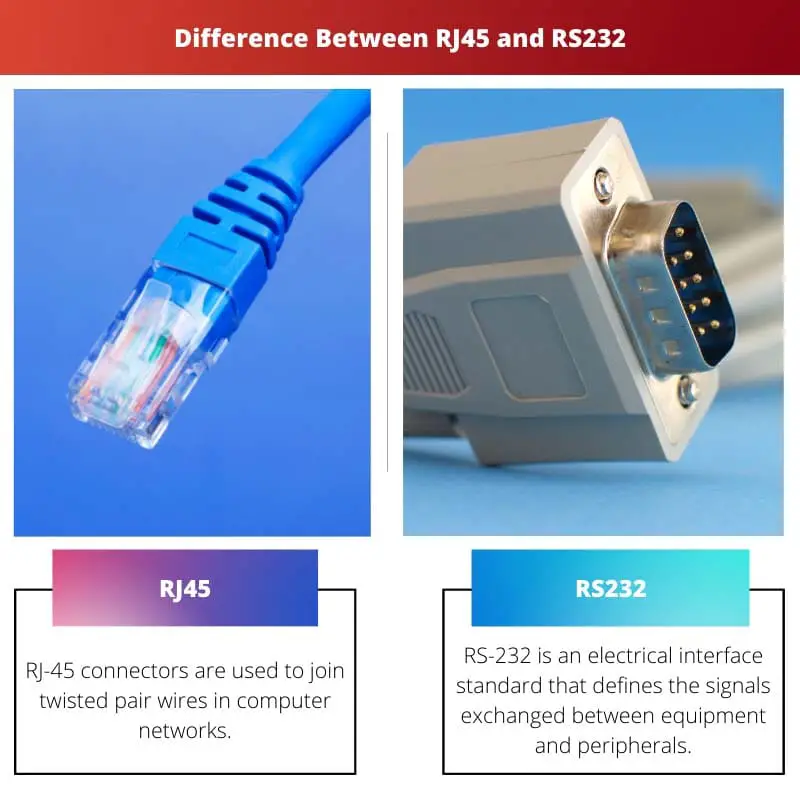RJ45 and RS232 are two different types of connectors that are used for different purposes. RJ45 is the standard connector type for wired Ethernet networks, while RS232 is mainly used for serial communication between devices.
A computer has 8 pins in an RJ45 port, while a modem has 25 pins in an RS232 port. RJ45 connectors are used to terminate twisted pair cables.
Key Takeaways
- RJ45 connectors are used for Ethernet networking in local area networks (LANs), while RS232 connectors are utilized for serial communication between devices.
- RJ45 connectors feature eight pins and a locking mechanism, while RS232 connectors have nine or 25 pins and lack a locking mechanism.
- RS232 is an older technology primarily used in industrial settings, whereas RJ45 is more common in modern networking applications.
RJ45 vs RS232
RJ-45 connectors are used to join twisted pair wires in computer networks. These connectors are made of plastic, and the structure is also called 8P8C. RS-232 is a standard for serial communication used in the computer industry to connect devices such as modems, printers, or microcomputers.

RJ-45 connectors are used to join twisted pair wires in computer networks. These connectors are made of plastic, and the structure is also called 8P8C.
It contains 8 pins for connecting devices and 8 connector sockets to accept the plug. RJ45 is a type of connector used to join network cables. RJ-45 is small in
RS-232, or EIA/TIA 553, is an electrical interface standard defining the signals exchanged between equipment and peripherals.
RS-232 was originally developed for use in telecommunication equipment by the Electronic Industries Association (EIA) and by the Telecommunications Industry Association (TIA), hence its name. This is used in serial connections particularly.
Comparison Table
| Parameters of Comparison | RJ45 | RS232 |
|---|---|---|
| Form | Standard Connector for Ethernet networks | Serial Connections |
| Number of pins | 8 | 9 |
| Size | Small | Big |
| Acts as | Interface | Industrial Applications |
| Usage | More | Less |
| Implementation | Simple | Difficult |
What is RJ45?
The most common type of network cable is the RJ-45, which looks like an overgrown phone jack. You can easily recognize it by its eight (8) wires in four (4) pairs.
The RJ-45 connector is used for 10BASE-T and 100BASE-TX networks. RJ45 connectors are used to terminate twisted pair cables.
It is the most common connector type in computer networking and is widely used for Ethernet. The most common RJ-45 pinout is T568A which has plugs with an “eight up, eight down” arrangement.
A T568B wiring scheme reverses two of the pairs (pins 2 and 3, 4 and 6) so that the console port on a router or switch can be wired straight through to a workstation.
It is the most commonly used connector in the world, but there are some common mistakes that can be made with it.
This article will go over those mistakes and how to avoid them. The first mistake you might make with RJ45 connectors is using them incorrectly.
While they are easy to use, you shouldn’t force anything into an RJ45 socket that won’t fit correctly. The key is ensuring that you have enough space around the edges of your cable to fit properly into the space.

What is RS232?
RS-232 is a standard for serial communication used in the computer industry to connect devices such as modems, printers, or microcomputers.
It was developed by IBM in 1969 and is widely implemented. In 1979, the Electronic Industries Alliance (EIA) published EIA-232.
This standard was similar to RS-232 but with different signal levels and character formats for use in equipment made by manufacturers who did not want to pay royalties on the use of RS-232 circuits.
It is the most common interface used in connecting computers and peripherals.
The RS232 standard was introduced by the Electronic Industries Association (EIA) in the 1970s, which later became the Telecommunications Industry Association (TIA).
The EIA/TIA successfully replaced all analogue standards with digital ones during that time.
This allowed for greater accuracy when sending data, but more importantly, it allowed for error control through parity checking.
A character-oriented interface that connects two devices using a serial data transmission protocol.
It was originally intended to connect computers and peripheral devices but is also used in low-level communications between devices such as printers, scanners, storage devices, etc.
RS-232 is a standard for serial communication lines between terminal data equipment and data circuit-terminating equipment.

Main Differences Between RJ45 and RS232
- RJ45 is the standard connector for Ethernet networks, but RS232 is used for serial connections.
- RJ45 supports 8 pins, but RS232 supports 9 pins.
- RJ45 port is smaller than the RS232 port.
- RJ45 is used as an interface, but RS232 is used in industrial applications.
- RJ45 is widely used as compared to RS232.
- RS232 is more difficult than RJ45.




